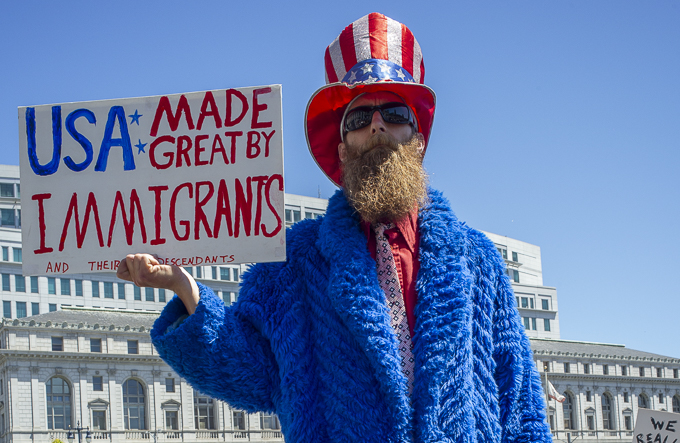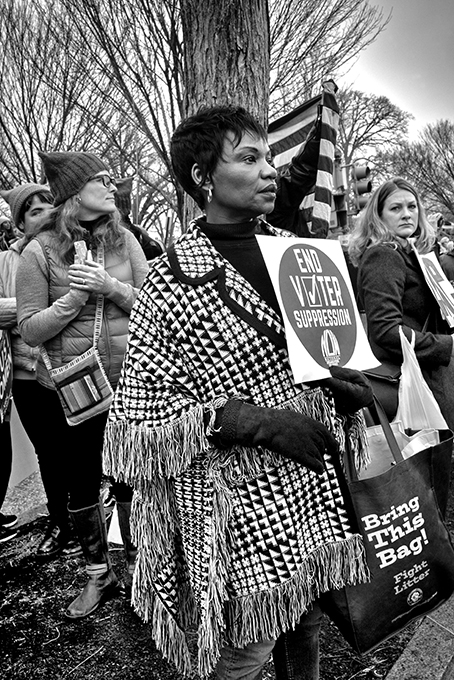Six Challenges for the Tough Year Ahead
By Max Elbaum
A mass slaughter of genocidal proportions backed by the current administration is taking place in Gaza. A candidate espousing US-style fascism has energized his base and makes no secret of his dictatorial day-one agenda. The opposition to MAGA is divided (on Gaza and immigration policy especially) and is not displaying the momentum anti-MAGA displayed at this stage of the 2020 campaign.
The people-power, energy, and savvy exist to regain the initiative. Different parts of the social justice movement will contribute in different ways. Here are six challenges that I think progressives must take on if we are to emerge from 2024 stronger than we are today.
1. Hammer home the danger—and look to what we can gain.
Keep sounding the alarm about the danger of MAGA while giving every component of the anti-MAGA majority a positive reason to vote against Trump.
Ignore all the pseudo-scientific polls—they are really just “punditry in disguise.” Instead, follow Michael Podhorzer’s lead and look at the results of the 2018, 2020, and 2022 elections to understand the behavior of the Trump-era electorate. The key takeaway is that there is an anti-MAGA majority in this country that wins elections when it is motivated to turn out.
One part of providing that motivation is hammering home the nature and danger of the MAGA agenda: The GOP “Mandate for Leadership” plan promises to overhaul government policy across the board to serve an agenda of “all wealth to the wealthy”; to-do lines include plans to expand use of fossil fuels, and to use the Justice Department against political opponents (which includes rounding up leftists). It’s not just Trump: Liz Cheney’s new book reports in detail on the depth and breadth of the Republican drive to break laws and overturn what remains of US democracy.
But fear of MAGA will not be enough. We will also need to convey what can be gained by a Democratic victory over MAGA and the ways defeating MAGA can increase the clout of grassroots-based and progressive organizations. To be effective, this kind of messaging must be focused and specific, sector by sector. For example, for winning workers of all racial backgrounds to vote against MAGA, stressing the pro-worker nature of the current NLRB and the prospect of it becoming an even more powerful defender of union organizing can be an important tool and something for other sectors to learn from.

On some issues, we can only make a strong case that there are gains to be made with a Democratic victory if we can push the Biden team to the left. Immigration policy, where the administration is considering caving to Republican pressure, and Biden’s “bear hug” backing of Israel (see next section) must be a focal point of progressive attention in the coming days and weeks. These issues are of special concern to constituencies that have made decisive contributions to the anti-MAGA front in the last few elections: Arabs and Muslims, youth and especially Black youth, peace and immigrants’ rights advocates. Only a broad progressive movement that throws down in the spirit of “an injury to one is an injury to all” can move the Democratic leadership on these issues, and thus help bring the energy of these too-often-marginalized sectors into the high-stakes 2024 electoral battle.
2. Ceasefire now!
Intensify the fight for a ceasefire and re-elect every pro-ceasefire member of Congress.
Intensifying pressure on Biden to join the rest of the world in demanding that Israel halt all military operations—with consequences if they don’t—is imperative. The pro-ceasefire movement continues to shift public opinion, and new initiatives such as the January 12-13 Emergency Summit for Gaza initiated by Jesse Jackson will squeeze the administration further.
Stepping up for elected officials who have come out for a ceasefire will be an essential piece of this fight. As of this writing, 56 representatives and four senators—all Democrats—have defied the administration and embraced the ceasefire demand. AIPAC and other Israel Lobby organizations, fearful that they are losing the “bipartisan consensus” that has long sustained blank-check-for-Israel policies, plan to spend over $100 million to defeat the most outspoken of these (Rashida Tlaib, Cori Bush, Jamaal Bowman, Summer Lee, Ilhan Omar) in Democratic primaries. As primary season comes closer, we can expect other pro-ceasefire representatives to be targeted too.
These primary battles will be the next major test of strength for the Palestine solidarity movement. If AIPAC’s assault can be beaten back, it will undermine the “fear factor” that is largely responsible for the big disconnect between sentiment at the base of the Democratic Party and the majority of its congress members. Such a victory would not just defend the foothold pro-Palestine sentiment already has in Congress, but provide a springboard to taking the offensive.
Gains in this battle would also bolster the case being made by this writer and others that our chances of beating MAGA are diminished unless Biden either changes course or steps aside in favor of a nominee not complicit in Israel’s genocide.
3. Don’t cede the fight against anti-Semitism.
Go on the offensive in fighting anti-Semitism.
Apologists for Israel—realizing that defending the country’s actions is a losing proposition—are steadily amplifying charges of anti-Semitism against the Palestine solidarity movement. In beating back those attacks, the Left has necessarily spent a lot of time and energy debunking the charge that anti-Zionism is anti-Semitic. In doing so, however, we have too often let ourselves get locked into purely defensive posture, which has made it easier for the apologists to advance the false charge that anti-Zionists care about what happens to Palestinians but don’t care about what happens to Jews.
We need to break this dynamic and go over to the offensive, making the case that the forces who are backing Israel today include the most diehard and dangerous anti-Semites: Christian Zionists who see Israel as prelude to a “rapture” when Evangelicals will go to heaven and Jews to hell, and white nationalists who see Jews as part of a “globalist” conspiracy to destroy America via “great replacement” through immigration. Further, the program of even the most liberal elements in the Zionist camp—a state in which Jews have special privileges and exclusive control the military and police—is inherently flawed.
It is the anti-Zionist Left—we who fight for equal rights for all in racially, ethnically, and religiously diverse societies—who are the most consistent opponents of anti-Semitism. It is our program, not theirs, that in actual practice as well as in theory means more safety for Jews. The Israeli ethno-state —supposedly a guarantee of Jewish safety—provides no such thing, as its dispossession and oppression of the Palestinians is a recipe for constant violence and war. Diverse societies where fights for racial, gender, and religious equality have made even incomplete breakthroughs are safest for Jews. And it is these very gains that are now under attack in the US by white Christian nationalists who boast of how pro-Israel they are, as if this immunized them from being anti-Semitic
A lot more work is required to turn these thoughts into a coherent program and, more important, an action strategy. But now is the time to get serious about it.
4. Build internationalism.
Beef up our internationalism and rebuild an antiwar, antimilitarist movement.
The unprecedented upsurge of pro-ceasefire activism does even more than create conditions for a major leap forward in building a more unified and broad-based Palestine solidarity movement.
As the first sustained movement at scale with internationalism at its center in more than a decade, it underscores both the need and the potential to make an internationalist vision and practice integral to the life of progressive groups focused on domestic issues. It also has thrust the militarist and anti-human rights character of US foreign policy in general into the spotlight, spurring discussions of how to revitalize peace and anti-militarist activism in general.
Again, a lot of thought and work will be required to take advantage of these opportunities. But the door is open at this moment in a way that it has not been for many years.
5. Seize history to explain our present and light our future.

Popularize a narrative about US history that explains how we got to our current circumstances and points to the social forces that can drive a Third Reconstruction.
The capacity to “shape people’s conscious and unconscious understandings of the world, of what is politically possible, and of their own place in the world” is integral to the fight for political power. Developing and popularizing a compelling narrative about this country’s past, present and future—one that “makes meaning” out of people’s disparate experiences and points in a liberatory direction—is imperative for a Left that aims to lead a coalition that can govern the country.
The rise of MAGA has led to new experiments in crafting such a narrative, often building on W.E.B. DuBois’ work centering the experience of the post-Civil War Reconstruction, and on lessons from the Second Reconstruction embodied in the 1950s-‘60s Civil Rights breakthroughs. Peniel Joseph’s book, The Third Reconstruction: America’s Struggle for Racial Justice in the Twenty-First Century, makes a major contribution. A new effort directly tied to grassroots activism, Two Americas on Contested Terrain: Constructing a White Supremacist Nation vs. Reconstructing a Rainbow Democracy, comes from Carl Davidson.
As we work towards strategic clarity and engage in the battle over the story of this country and its future, work in this direction has a lot to offer.
6. Keep hope alive: courage is contagious!
It will be difficult to meet all the challenges flagged here as well as others that face us in the tough year ahead. We will have to be real about the power of our enemies while remaining confident that appealing to the majority’s “better angels” can create a force that overcomes that power. In this effort, stories of what individuals can do in the face of adversity tend to have more power than even the most insightful analysis of each side’s strengths and weaknesses. We are in a moment when such stories abound:
- Palestinian journalists working in Gaza are paying “a staggeringly high price these last two months for the twin perils of being Palestinian and covering the war. Those who have dedicated their lives to uncovering and sharing the stories of people who have suffered a 16-year blockade and have seen their Western and Palestinian colleagues killed, maimed, and imprisoned by the Israeli military and censored by its tech allies…‘It’s time for Gaza’s Journalists to be treated like the heroes they are.’”
- “A young Israeli man was sentenced Tuesday to 30 days behind bars for refusing to enlist in the Israel Defense Forces as it wages a genocidal assault on Gaza, a war the teen condemned as ‘a revenge campaign… not only against Hamas, but against all Palestinian people.’“
- “Black mother-daughter Georgia election workers Ruby Freeman and Shaye Moss stood strong against the most vile life-threatening danger” after Trump toady Rudy Giuliani and a host of right-wing media outlets falsely accused them of ballot tampering. “People called for the two to be hung at the Capitol where witnesses could ‘hear their necks snap.’” They may never receive any of the $148 million the jury awarded them, but they faced down their defamers and won.
These stories gain even more power in the context of the collective courage being displayed week after week by people standing up, sitting in, speaking out, risking their comfort and careers—and in Gaza simply struggling to keep their families, neighbors and themselves alive. All these stories bring our inspiration and hope. Let’s lift them up.
…
This piece originally ran in Convergence
Think that Bernie’s analysis that to beat Trump there needs to be a program advanced that provides hope for the economic needs of the working class is spot on.
https://apple.news/AG62HSWZNRuK14DS7Xn-WNw
Thanks, Max